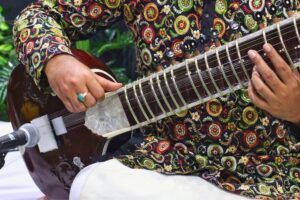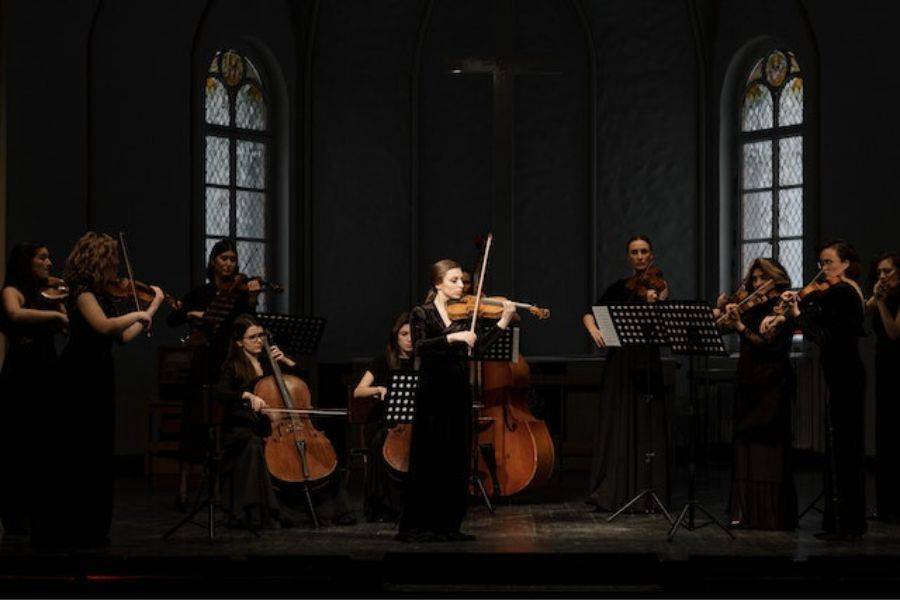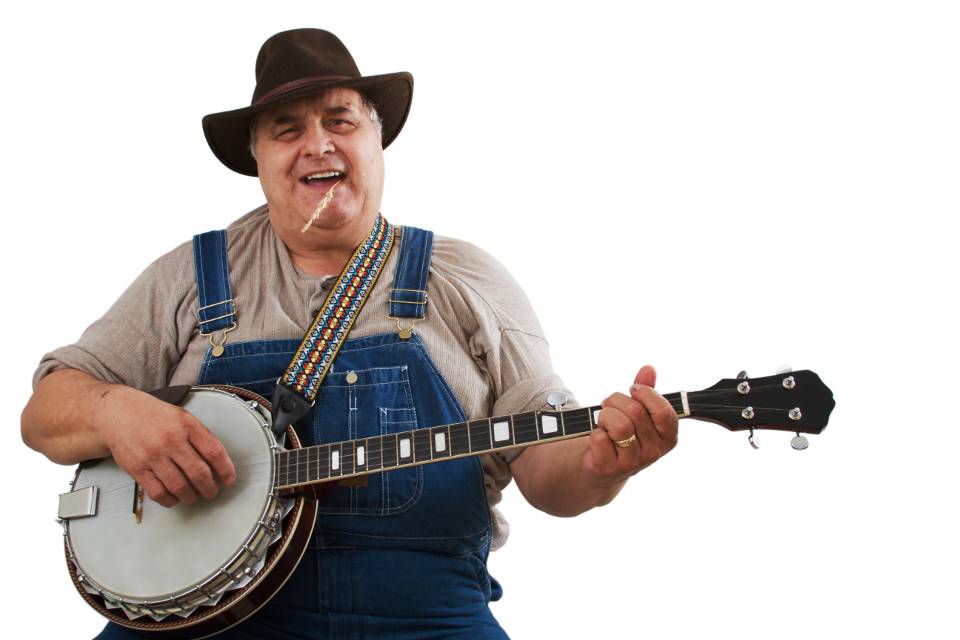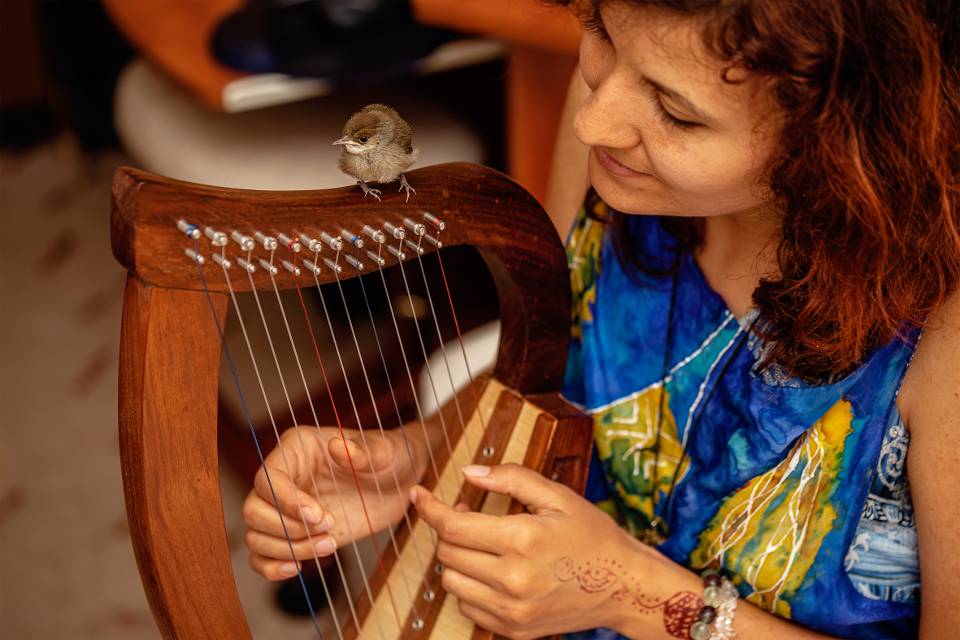The orchestra is composed of string, woodwind, brass, and percussion instruments.

String instruments make up a large number of instruments typically found in the standard orchestra lineup.
Here are a few ones that are not typically found in an orchestra and why.
Contents
Banjo
A string instrument with a round body and a long neck is commonly used in folk, bluegrass, and country music. It is often played in smaller ensembles or as a solo instrument.
With its bright sound, it is percussive and distinctive. However, in an orchestral setting, the banjo’s volume and tonal characteristics may not blend well with the other instruments.
Orchestras typically aim for a balanced sound across the different sections. The banjo’s unique timbre might not easily fit into that landscape.
Although the banjo is not a typical instrument in orchestras, there have been instances where composers have included it in specific orchestral compositions.
This could be in more contemporary or crossover works that blend different musical styles.
Mandolin
The mandolin is a small, pear-shaped instrument with a fretted neck and typically four pairs of strings. It is commonly used in folk, bluegrass, and classical music.
The mandolin is played by plucking or strumming the strings with a pick. It is a relatively small instrument with limited volume and projection capabilities.
This is why it is not used in the orchestra. Orchestras typically consist of a large number of musicians playing a wide range of instruments.
The soft and delicate sound of the mandolin may not be projected well over the rest of the orchestra.
Ukulele
A small, four-stringed instrument with a sound resembling a classical guitar. It is commonly associated with Hawaiian music but is also used in various genres.
The ukulele is played by strumming or plucking the strings. The ukulele is a small instrument with relatively limited volume and projection capabilities.
Its soft and delicate sound may struggle to be heard over the larger and louder instruments.
Thus, it is commonly seen as more of a solo or accompanying instrument rather than part of an orchestral ensemble.
Dobro
This is also known as a resonator guitar. The dobro is a type of acoustic guitar with a metal resonator cone built into the body.
It is played horizontally and is often used in blues, bluegrass, and country music.
The dobro’s playing style often involves slide techniques, open tunings, and bluesy phrasing. This may not easily blend with the traditional orchestral sound.
Saxophone
Originally, saxophones were not in the orchestra. This was due to the belief that they did not integrate with the other instruments.
However, saxophones are now frequently used in contemporary compositions. Notably, the saxophone still has a selective usage in the orchestra.
The saxophone’s distinctive timbre and being a member of the woodwind family can be both an advantage and a challenge
Sitar

The sitar is a long-necked, stringed instrument with a gourd-shaped body. It has a unique sound and is used in classical Indian music.
The sitar is played by plucking the strings and using various techniques, including sliding and bending the strings.
It would not be easy to adapt the sitar’s playing style, tuning, and techniques to fit within an orchestral context.
This would require special arrangements or compositions specifically tailored for the instrument.
Bouzouki
A Greek string instrument with a long neck and a pear-shaped body.
It has either three or four pairs of metal strings and is played by plucking or strumming. The bouzouki is commonly used in Greek folk music.
Cittern
An instrument from the Renaissance and Baroque periods. The cittern has a flat, pear-shaped body and wire strings.
It is played by plucking or strumming and was popular in Europe during the 16th and 17th centuries.
Electric and Bass Guitar
A modern variation of the guitar that uses electronic pickups to convert the vibration of its steel strings into electrical signals.
It is widely used in various genres such as rock, blues, jazz, and pop. The bass guitar is also similar in appearance to an electric guitar but with a longer neck and thicker strings.
It provides the low-end foundation in many genres of music, including rock, funk, jazz, and reggae.
Oud
A pear-shaped, fretless instrument commonly used in Middle Eastern and North African music. The oud has a deep, resonant sound and is played by plucking the strings with a pick or fingers.
There have been cross-cultural collaborations featuring the oud in Western orchestras or orchestral settings influenced by Middle Eastern music.
In such cases, the oud may be featured as a solo instrument. It may be used in ensemble settings that combine elements of these musical traditions.
Chapman Stick
The Chapman stick is a unique instrument with a long fretboard and multiple strings. It is typically played by tapping or using a combination of tapping and strumming.
It is known for its versatility and is used in various genres, including progressive rock and jazz.
Chapman’s design and playing technique is distinct from the instruments typically found in traditional orchestras.
These are just a few examples of string instruments that are not typically found in the standard orchestra.
Each instrument brings its distinct sound and style to the music it is used in.
However, they are widely used in various musical genres and have their own unique characteristics and playing techniques.
Why Are These Instruments Not Played in the Orchestra?

The selection of instruments in an orchestra is based on various factors: historical tradition, musical requirements, and the specific sound palette desired by the composer.
While there is some flexibility in the choice of instruments, certain instruments may not be included in the standard orchestra.
Historical Tradition
The standard orchestra, as we know it today, has evolved over several centuries. Its instrumental line-up has been largely shaped by the classical music tradition.
Instruments like the violin, cello, flute, oboe, clarinet, trumpet, and timpani have a long-standing history in orchestral music.
Hence, they have become the foundation of the ensemble.
Musical Requirements
Orchestral compositions often have specific musical demands. This includes a wide range of tonal colors, dynamics, and textures.
The standard orchestra is designed to cover a broad spectrum of musical expression.
Therefore, the chosen instruments are selected to achieve this range effectively.
Other instruments, while valuable in their own right, may not offer the same versatility or blend with the existing ensemble.
Balance and Music Blending
Orchestral music relies on achieving a balanced and cohesive sound across different sections and instrumental families. The standard orchestra is carefully curated.
A combination of instruments that complement each other in terms of timbre, volume, and projection.
Adding new or unconventional instruments may disrupt the established balance and could make it challenging to achieve the desired blend.
Practical Considerations
The standard orchestra is already a sizable ensemble. Adding more instruments may present logistical challenges in terms of stage space, seating, and organization.
Additionally, including less common instruments would require additional resources for acquiring, maintaining, and rehearsing those instruments. This may not be feasible for all orchestras.
Occasionally, orchestras incorporate non-standard instruments or guest musicians to perform specific pieces or genres.
Composers may also write pieces that call for non-traditional instruments, expanding the possibilities of orchestral instrumentation.
Ultimately, the choice of instruments in an orchestra is determined by the musical needs and artistic vision of the composers.






